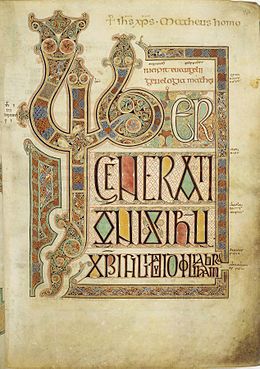
The Lindisfarne Gospels (London, British Library Cotton MS Nero D.IV) is an illuminated manuscript gospel book probably produced around the years 715–720 in the monastery at Lindisfarne, off the coast of Northumberland, which is now in the British Library in London.[1] The manuscript is one of the finest works in the unique style of Hiberno-Saxon or Insular art, combining Mediterranean, Anglo-Saxon and Celtic elements.[2]
The Lindisfarne Gospels are presumed to be the work of a monk named Eadfrith, who became Bishop of Lindisfarne in 698 and died in 721.[3] Current scholarship indicates a date around 715, and it is believed they were produced in honour of St. Cuthbert. However, some parts of the manuscript were left unfinished so it is likely that Eadfrith was still working on it when he died.[3] It is also possible that he produced them prior to 698, in order to commemorate the elevation of Cuthbert's relics in that year,[4] which is also thought to have been the occasion for which the St Cuthbert Gospel (also in the British Library) was produced. The Gospels are richly illustrated in the insular style and were originally encased in a fine leather treasure binding covered with jewels and metals made by Billfrith the Anchorite in the 8th century. During the Viking raids on Lindisfarne this jewelled cover was lost and a replacement was made in 1852.[5] The text is written in insular script, and is the best documented and most complete insular manuscript of the period.
An Old English translation of the Gospels was made in the 10th century: a word-for-word gloss of the Latin Vulgate text, inserted between the lines by Aldred, Provost of Chester-le-Street. This is the oldest extant translation of the Gospels into the English language.[6] The Gospels may have been taken from Durham Cathedral during the Dissolution of the Monasteries ordered by Henry VIII and were acquired in the early 17th century by Sir Robert Cotton from Robert Bowyer, Clerk of the Parliaments. Cotton's library came to the British Museum in the 18th century and went to the British Library in London when this was separated from the British Museum.[7]
- ^ "Lindisfarne Gospels" The British Library, in 2018 dates it "c. 715-720".
- ^ Hull, Derek (2003). Celtic and Anglo-Saxon Art: Geometric Aspects. Liverpool: Liverpool University Press. ISBN 0-85323-549-X.
- ^ a b Lindisfarne Gospels British Library. Retrieved 2008-03-21
- ^ Backhouse, Janet (1981). The Lindisfarne Gospels. Phaidon. ISBN 9780714824611.
- ^ Let Gospels come home Archived 19 February 2009 at the Wayback Machine Sunderland Echo, 2006-09-22. Retrieved 2008-03-21
- ^ "The Lindisfarne Gospels". Northumbrian Association. Archived from the original on 20 June 2012. Retrieved 24 December 2012.
- ^ Time line British Library. Retrieved 2008-03-21